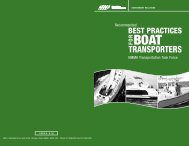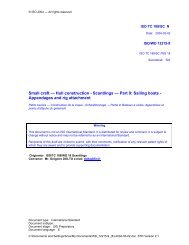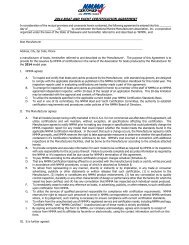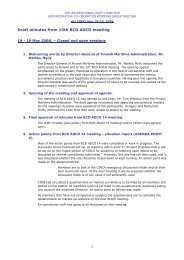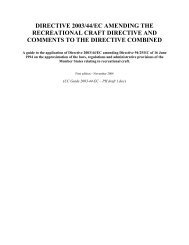global environmental legislation guide - National Marine ...
global environmental legislation guide - National Marine ...
global environmental legislation guide - National Marine ...
Create successful ePaper yourself
Turn your PDF publications into a flip-book with our unique Google optimized e-Paper software.
into consideration the costs and advantages, whether or not the techniques are used orproduced inside the Member State in question, as long as they are reasonably accessibleto the operator.3. ‘Best’ means most effective in achieving a high general level of protection of theenvironment as a whole.The IED also defines 'BAT conclusions' as the parts of a BREF laying down theconclusions on BAT, their description, information to assess their applicability, the emission levelsassociated with the BAT, associated monitoring, associated consumption levels and, whereappropriate, relevant site remediation measures. The BAT conclusions are to be adopted throughthe procedure referred to in the IED (implementing acts).They shall be the reference for setting (environment and emission) permit conditions for theinstallations covered by the IED. As mentioned in the IED, the main aim of a BREF is to determineBAT, and to limit imbalances in the EU as regards the level of emissions from industrial activities.BREFs should provide information to the competent authorities of Member States, industrialoperators, the Commission and the public at large on what BAT and emerging techniques are forthe activities covered by the IED.III. 'Horizontal' and 'vertical' BREFsBREFs may either be restricted to issues related to particular industrial activities ('vertical' BREFs)or may deal with cross-sectoral issues ('horizontal' BREFs), such as monitoring, economics andcross media effects, industrial cooling systems, emissions from storage, common waste water andwaste gas treatment/management systems in the chemical sector and energy efficiency.'Horizontal' and 'vertical' BREFs should be developed so as to be complementary for the purposeof setting permit conditions for installations covered by the IED. The 'horizontal' BREFs includeinformation of a generic nature that can be used across many activities which fall under the scopeof the IED. Information should be included in 'horizontal' BREFs where this supplements theinformation contained in 'vertical' BREFs on aspects that cut across several industrial sectors. Inorder to facilitate the use of both 'vertical' and 'horizontal' BREFs in a complementary way,appropriate cross-references need to be made in a BREF to other relevant 'vertical' and'horizontal' BREFs.In The Netherlands there are some good and positive experiences with horizontal and verticalBREFs, and being used in the “Industrial Activity Permit Conditions “which started in the late ‘90’sand finalized around 2005. For example in the Industrial Activity Permit Conditions the MarinaPermit Conditions (developed in coordination with Competent Authorities and Industry) werewith success integrated!IV. General procedure for drawing up and reviewing of BREFsThe Commission organises and coordinates the exchange of information through the involvementof the European IPPC Bureau (EIPPCB, within DG Joint Research Centre) and DG Environment.The stakeholders involved in the exchange of information as stipulated in the IED(Member States, industries concerned, <strong>environmental</strong> NGOs, and the Commission) oversee theprocess through the Forum established according to IED. They contribute to the drawing up andreviewing of BREFs by participating in the technical working groups (TWGs).



